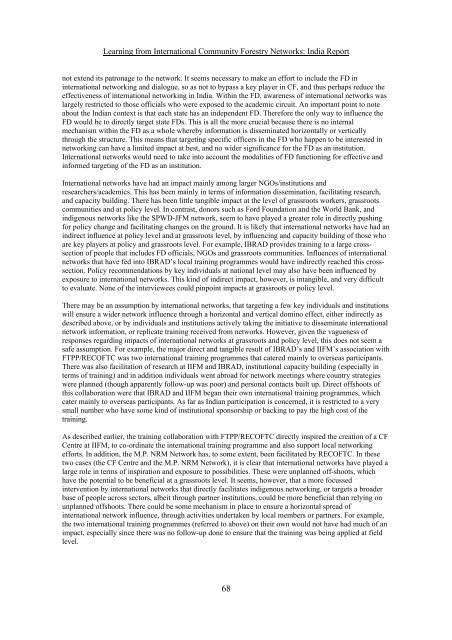Snapshots of International Community Forestry Networks: Country ...
Snapshots of International Community Forestry Networks: Country ...
Snapshots of International Community Forestry Networks: Country ...
Create successful ePaper yourself
Turn your PDF publications into a flip-book with our unique Google optimized e-Paper software.
Learning from <strong>International</strong> <strong>Community</strong> <strong>Forestry</strong> <strong>Networks</strong>: India Report<br />
not extend its patronage to the network. It seems necessary to make an effort to include the FD in<br />
international networking and dialogue, so as not to bypass a key player in CF, and thus perhaps reduce the<br />
effectiveness <strong>of</strong> international networking in India. Within the FD, awareness <strong>of</strong> international networks was<br />
largely restricted to those <strong>of</strong>ficials who were exposed to the academic circuit. An important point to note<br />
about the Indian context is that each state has an independent FD. Therefore the only way to influence the<br />
FD would be to directly target state FDs. This is all the more crucial because there is no internal<br />
mechanism within the FD as a whole whereby information is disseminated horizontally or vertically<br />
through the structure. This means that targeting specific <strong>of</strong>ficers in the FD who happen to be interested in<br />
networking can have a limited impact at best, and no wider significance for the FD as an institution.<br />
<strong>International</strong> networks would need to take into account the modalities <strong>of</strong> FD functioning for effective and<br />
informed targeting <strong>of</strong> the FD as an institution.<br />
<strong>International</strong> networks have had an impact mainly among larger NGOs/institutions and<br />
researchers/academics. This has been mainly in terms <strong>of</strong> information dissemination, facilitating research,<br />
and capacity building. There has been little tangible impact at the level <strong>of</strong> grassroots workers, grassroots<br />
communities and at policy level. In contrast, donors such as Ford Foundation and the World Bank, and<br />
indigenous networks like the SPWD-JFM network, seem to have played a greater role in directly pushing<br />
for policy change and facilitating changes on the ground. It is likely that international networks have had an<br />
indirect influence at policy level and at grassroots level, by influencing and capacity building <strong>of</strong> those who<br />
are key players at policy and grassroots level. For example, IBRAD provides training to a large crosssection<br />
<strong>of</strong> people that includes FD <strong>of</strong>ficials, NGOs and grassroots communities. Influences <strong>of</strong> international<br />
networks that have fed into IBRAD’s local training programmes would have indirectly reached this crosssection.<br />
Policy recommendations by key individuals at national level may also have been influenced by<br />
exposure to international networks. This kind <strong>of</strong> indirect impact, however, is intangible, and very difficult<br />
to evaluate. None <strong>of</strong> the interviewees could pinpoint impacts at grassroots or policy level.<br />
There may be an assumption by international networks, that targeting a few key individuals and institutions<br />
will ensure a wider network influence through a horizontal and vertical domino effect, either indirectly as<br />
described above, or by individuals and institutions actively taking the initiative to disseminate international<br />
network information, or replicate training received from networks. However, given the vagueness <strong>of</strong><br />
responses regarding impacts <strong>of</strong> international networks at grassroots and policy level, this does not seem a<br />
safe assumption. For example, the major direct and tangible result <strong>of</strong> IBRAD’s and IIFM’s association with<br />
FTPP/RECOFTC was two international training programmes that catered mainly to overseas participants.<br />
There was also facilitation <strong>of</strong> research at IIFM and IBRAD, institutional capacity building (especially in<br />
terms <strong>of</strong> training) and in addition individuals went abroad for network meetings where country strategies<br />
were planned (though apparently follow-up was poor) and personal contacts built up. Direct <strong>of</strong>fshoots <strong>of</strong><br />
this collaboration were that IBRAD and IIFM began their own international training programmes, which<br />
cater mainly to overseas participants. As far as Indian participation is concerned, it is restricted to a very<br />
small number who have some kind <strong>of</strong> institutional sponsorship or backing to pay the high cost <strong>of</strong> the<br />
training.<br />
As described earlier, the training collaboration with FTPP/RECOFTC directly inspired the creation <strong>of</strong> a CF<br />
Centre at IIFM, to co-ordinate the international training programme and also support local networking<br />
efforts. In addition, the M.P. NRM Network has, to some extent, been facilitated by RECOFTC. In these<br />
two cases (the CF Centre and the M.P. NRM Network), it is clear that international networks have played a<br />
large role in terms <strong>of</strong> inspiration and exposure to possibilities. These were unplanned <strong>of</strong>f-shoots, which<br />
have the potential to be beneficial at a grassroots level. It seems, however, that a more focussed<br />
intervention by international networks that directly facilitates indigenous networking, or targets a broader<br />
base <strong>of</strong> people across sectors, albeit through partner institutions, could be more beneficial than relying on<br />
unplanned <strong>of</strong>fshoots. There could be some mechanism in place to ensure a horizontal spread <strong>of</strong><br />
international network influence, through activities undertaken by local members or partners. For example,<br />
the two international training programmes (referred to above) on their own would not have had much <strong>of</strong> an<br />
impact, especially since there was no follow-up done to ensure that the training was being applied at field<br />
level.<br />
68

















![CynefinFramework final [Read-Only]](https://img.yumpu.com/19017304/1/190x135/cynefinframework-final-read-only.jpg?quality=85)